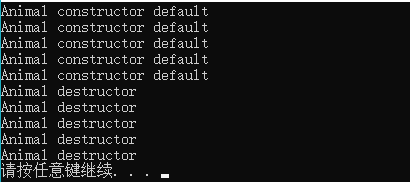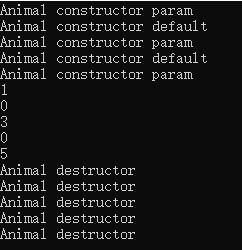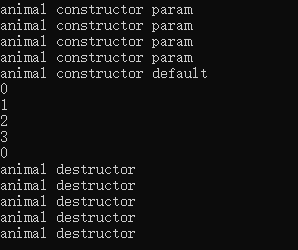C++中若類中沒有預設建構函式,如何使用物件陣列
阿新 • • 發佈:2019-08-24
前言:
如果定義一個類,有其預設的建構函式,則使用new動態例項化一個物件陣列,不是件難事,如下程式碼:
1 #include <memory>
2 #include <iostream>
3
4 using namespace std;
5
6 class Animal
7 {
8 public:
9 #if 1 //用於後面演示,無預設建構函式
10 Animal() : num(0)
11 {
12 cout << "Animal constructor default" << endl;
13 }
14 #endif
15 Animal(int _num) : num(_num)
16 {
17 cout << "Animal constructor param" << endl;
18 }
19
20 ~Animal()
21 {
22 cout << "Animal destructor" << endl;
23 }
24
25 void show()
26 {
27 cout << this->num << endl;
28 }
29
30 private:
31 int num;
32 };
33
34 int main()
35 {
36 Animal *ani = new Animal[5];
37
38 delete[]ani;
39
40 system("pause");
41 return 0;
42 }執行結果:

但是,如果沒有預設建構函式,會出現怎麼樣呢?
看下圖報錯提示:

那要如何例項化一個沒有預設建構函式的物件陣列呢?
下面我將介紹兩種方法:
1. 使用C++11新特性allocator類
2. 使用placement new 即operator new(第三個過載版本)void* operator new(size_t size, void *p)函式
一、allocator類
對於allocator類,請看 我的另一篇blog http://www.cnblogs.com/SimonKly/p/7819122.html
請看一下程式碼關於使用如何實現無預設建構函式,動態例項化物件陣列的allocator方法

1 //#include "CAnimal.h"
2 #include <memory>
3 #include <iostream>
4
5 using namespace std;
6
7 class Animal
8 {
9 public:
10 #if 1 //即使為0,沒有預設構造也是可以,
11 Animal() : num(0)
12 {
13 cout << "Animal constructor default" << endl;
14 }
15 #endif
16 Animal(int _num) : num(_num)
17 {
18 cout << "Animal constructor param" << endl;
19 }
20
21 ~Animal()
22 {
23 cout << "Animal destructor" << endl;
24 }
25
26 void show()
27 {
28 cout << this->num << endl;
29 }
30
31 private:
32 int num;
33 };
34
35 /*
36 由於allocator將記憶體空間的分配和物件的構建分離
37 故使用allocator分為以下幾步:
38 1.allocator與類繫結,因為allocator是一個泛型類
39 2.allocate()申請指定大小空間
40 3.construct()構建物件,其引數為可變引數,所以可以選擇匹配的建構函式
41 4.使用,與其它指標使用無異
42 5.destroy()析構物件,此時空間還是可以使用
43 6.deallocate()回收空間
44 */
45
46 int main()
47 {
48 allocator<Animal> alloc; //1.
49 Animal *a = alloc.allocate(5); //2.
50
51 //3.
52 alloc.construct(a, 1);
53 alloc.construct(a + 1);
54 alloc.construct(a + 2, 3);
55 alloc.construct(a + 3);
56 alloc.construct(a + 4, 5);
57
58 //4.
59 a->show();
60 (a + 1)->show();
61 (a + 2)->show();
62 (a + 3)->show();
63 (a + 4)->show();
64
65 //5.
66 for (int i = 0; i < 5; i++)
67 {
68 alloc.destroy(a + i);
69 }
70 //物件銷燬之後還可以繼續構建,因為構建和記憶體的分配是分離的
71 //6.
72 alloc.deallocate(a, 5);
73
74 cin.get();
75 return 0;
76 }
執行結果

通過執行結果可以看出,無論是否有預設構造,allocator會選擇出最匹配的建構函式(過載)
二、placement new
函式原型:
void* operator new(size_t size, void* p) throw();
函式執行忽略size,只返回p指標,不分配記憶體。
placement new具體的用法和相關技術點,請參看我的另一篇博文的第三節
http://www.cnblogs.com/SimonKly/p/7826651.html
具體實現:C++中若類中沒有預設建構函式,如何使用物件陣列??
請看下面的程式碼:
1 #include <iostream>
2
3 using namespace std;
4
5 class animal
6 {
7 public:
8 #if 1 //用於後面演示,無預設建構函式
9 animal() : num(0)
10 {
11 cout << "animal constructor default" << endl;
12 }
13 #endif
14 animal(int _num) : num(_num)
15 {
16 cout << "animal constructor param" << endl;
17 }
18
19 ~animal()
20 {
21 cout << "animal destructor" << endl;
22 }
23
24 void show()
25 {
26 cout << this->num << endl;
27 }
28
29 void * operator new(size_t size, void *p)
30 {
31 return p;
32 }
33
34 private:
35 int num;
36 };
37
38
39 int main(int args, char ** argv)
40 {
41 // 一個動態animal陣列
42 void *p = operator new(5 * sizeof(animal)); // 申請緩衝器
43 animal *a = static_cast<animal *>(p); // 轉換型別
44
45 // 2.物件構建
46 for (int i = 0; i < 4; i++)
47 {
48 new(a + i) animal(i);// 呼叫過載構造
49 }
50 new(a + 4) animal; // 也可以呼叫預設構造
51
52 // 3.使用
53 for (int i = 0; i < 5; i++)
54 {
55 (a + i)->show();
56 }
57
58 // 4.銷燬物件
59 for (int i = 0; i < 5; i++)
60 {
61 (a + i)->~animal();
62 }
63
64 // 5.回收空間
65 delete[]p;
66
67 cin.get();
68 return 0;
69 }
執行結果:

通過執行結果可以看出,無論是否有預設構造,placement new會向已經申請的空間

